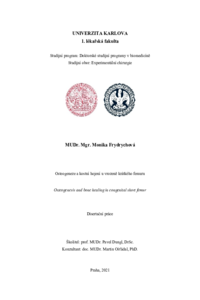Osteogeneze a kostní hojení u vrozeně krátkého femuru
Osteogenesis and bone healing in congenital short femur
dissertation thesis (DEFENDED)

View/
Permanent link
http://hdl.handle.net/20.500.11956/171404Identifiers
Study Information System: 154088
Collections
- Kvalifikační práce [4588]
Author
Advisor
Consultant
Ošťádal, Martin
Referee
Havlas, Vojtěch
Charvát, Jan
Faculty / Institute
First Faculty of Medicine
Discipline
Experimental Surgery
Department
Department of Orthopaedics First Faculty of Medicine Charles University and Bulovka University Hospital
Date of defense
27. 1. 2022
Publisher
Univerzita Karlova, 1. lékařská fakultaLanguage
Czech
Grade
Pass
Keywords (Czech)
vrozeně krátký femur, genová exprese, angiogeneze, osteogeneze, kostní hojení, prolongace femuruKeywords (English)
Proximal femoral focal deficiency, Gene Expression, Angiogenesis, Osteogenesis, Bone healing, Prolongation of the femurSouhrn Úvod: Vrozeně krátký femur, neboli proximální femorální fokální deficience (PFFD), je vzácná komplexní vada dolní končetiny s maximem postižení na femuru. Nálezy zahrnují širokou škálu variant od kompletní absence femuru až po nenápadný zkrat. Cíl studie: 1. Molekulární analýza patologické kostní tkáně u vrozeně krátkého femuru se zaměřením na expresi angiogenních a osteogenních faktorů v porovnání s fyziologickou kostí. Očekávané byly rozdíly v genové expresi obou skupin genů, zejména v jejich množství. 2. Retrospektivní analýza hojení femuru po prolongaci s ohledem na závažnost postižení, věk, délku prolongátu a s tím spojené komplikace. Předpokladem bylo prodloužené kostní hojení u závažnějších defektů končetiny, u starších pacientů, u pacientů s PFFD v porovnání s kontrolní skupinou. Materiál a metody: Z bloku kostní tkáně byla izolována RNA a biočipovou technikou zjištěn transkripční profil (SuperArray Bioscience Corporation) s možností detekce 113 genů osteogeneze a 113 genů angiogeneze. Bylo analyzováno celkem 10 vzorků (7 PFFD, 3 kontrolní). K prolongaci končetiny byli indikováni pacienti s typy Pappas III a IV (s pakloubem femuru) a pacienti s typy VII, VIII a IX. Byla analyzována data u 57 pacientů s PFFD a 12 pacientů kontrolní skupiny. Statické zpracování probíhalo metodou GLS. Výsledky:...
Introduction: Congenital short femur, or proximal femoral focal deficiency (PFFD), is a rare complex deformity of the lower extremity with femoral dominance. The clinical findings cover wide range of variety, from femoral absence till inconspicuous shortening of the femur. Aim of the study: 1. Molecular analysis of pseudoarthrosis tissue in congenital short femur with focusing on osteogenic and angiogenic gene expression in comparison with physiological bone. The differences in gene expression were expected. 2. Retrospective analysis of femoral healing after prolongation calculating the severity of affection, age, distance of elongation and complication. The extended healing according to severity type and age was expected compared to control group. Material and methods: The RNA from piece of one was isolated and transcription profile of possible 113 genes of osteogenesis and angiogenesis was detected by biochip technology (SuperArray Bioscience Corporation). 10 samples analyses were performed (7 of PFFD, 3 controls). The data of 57 PFFD patients indicated for elongation of the femur with the types Pappas III, IV, VII, VIII and IX and 12 patients in control group were evaluated retrospectively and statistically by GLS method. Results: The expected differences in gene expression in PFFD tissue...
